#spiced chickpea salad
Text
Moroccan spiced chickpea salad
Ingredients
3 cans chickpeas, rinsed and dried
1/2 cup red onion, diced
1/3 cup red pepper, diced
1/2 cup apple, diced
1/2 cup mint, chopped
1/2 cup cilantro, chopped
1 cup dried cranberries raisins work too
1 Lemon, zested and juiced
3 tbs red wine vinegar
1 tbs honey
1 tsp cumin
1 tsp cinnamon
1 tsp curry powder
2 tsp salt
1 tsp olive oil
Instructions
Grab yourself a large bowl and add all ingredients together. Mix thoroughly. Store in fridge for up to 5 days.
Source: Andy’s East Coast Kitchen
#chickpea salad#recetas caseras#so yummy#good eats#healthy eating#healthy food#how to eat healthy#delicioso#recetas#healthy food recipes#food#spiced chickpea salad#vegan cooking#veganfood#go vegan#veganrecipes#vegan food#home cooking#vegetarian#recipe#vegan#veganism#Moroccan spiced chickpea salad#Moroccan chickpea salad#recetas saludables#how to make a good summer salad
2 notes
·
View notes
Text

Ginger-Miso-Yuzu Kale Salad (Vegan)
#vegan#lunch#dinner#salad#kale#seaweed#cabbage#tomatoes#tofu#mushrooms#sweet potatoes#chickpeas#yuzu#sichuan peppercorns#teriyaki sauce#chinese 5 spice#ginger#mirin#miso#garlic#soy sauce#chili#sesame oil#sea salt#eat the rainbow
92 notes
·
View notes
Text
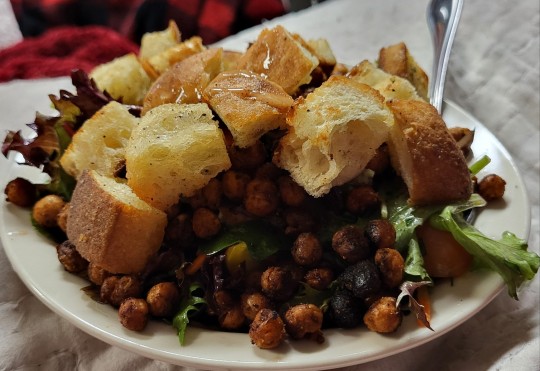
This roasted chickpea salad is a frickin mountain of food holy cripes
#very tasty. the chickpeas are flavored with shwarma spice and roasted all crispy#salad#food#hubby jon made it :)#with the help of#hello fresh#hey hello fresh. i keep talking about your food. give me free stuff please
1 note
·
View note
Text
Vegan Kale and Sweet Potato Noodle Caesar Salad with Crispy Spiced Chickpeas
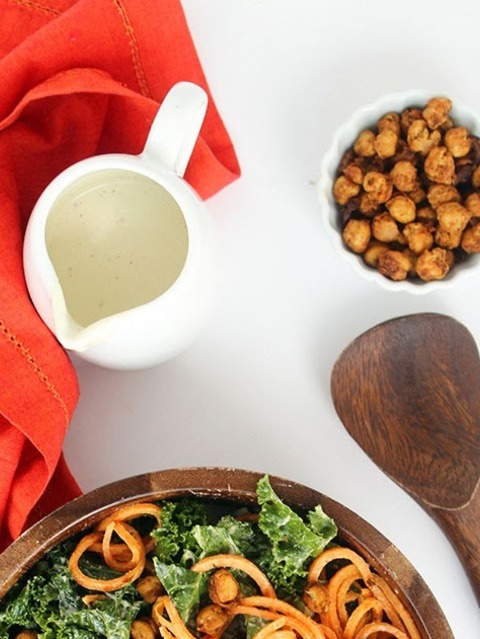
1 note
·
View note
Photo

Mediterranean Farro Salad with Spiced Chickpeas
0 notes
Photo

Spiced Rubbed Salmon with Chickpea Salad
0 notes
Text
Vegan Kale and Sweet Potato Noodle Caesar Salad with Crispy Spiced Chickpeas

0 notes
Text
Middle Eastern Chickpea and Puffed Rice Salad
I love trying new ingredients when I see them on a cooking programme. Puffed rice is my new thing. I don’t know what I expected but it is just a savoury cereal puff. Its genius putting it in a salad as it adds such a nice texture and nuttiness. I love textures in salads, and this worked really well. The crunchy cumin and mustard seeds are really nice pop of flavour. I am also a little bit…

View On WordPress
0 notes
Text
Moroccan Ras El Hanout Chorizo and Chickpea Salad
I had some ras el hanout in the back of the cupboard and thought I better use it for something. As it’s Middle Eastern chickpeas came to mind and I thought I’d do a tasty salad. This salad was amazing! The spicy chorizo, warming spices and zingy preserved lemon. I am also addicted to semi dried tomatoes at the moment as they are so sweet. I could eat a pot on my own.
Ingredients (serves 2)
For…
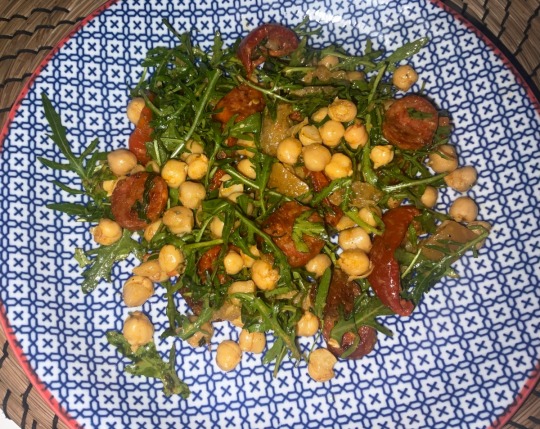
View On WordPress
0 notes
Photo
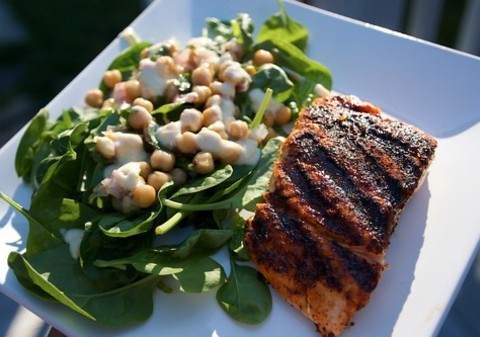
Spiced Rubbed Salmon with Chickpea Salad
0 notes
Text
Under 150 kcal whole-food, vegan recipes ❤️ SO MUCH FLAVOR! 🌿 no sweets
Vegan Mushroom Stroganoff (120 kcal)
Root Vegetable Salad with Sweet Potato Crunchies (79 kcal)
Slow Cooker Sweet Potato and Kale Soup (130 kcal)
Christmas Spiced Red Cabbage (use vegan butter/oil) (79 kcal)
Charred Onion and Tomato Salad (81 kcal)
Baked Apple Chips (32 kcal)
Chimichurri Sauce, Oil-Free (I would put over large portabella cap for ~+20 kcal) (8 kcal)
Baked Zucchini Tater Tots (104 kcal)
Air Fryer Beet Chips, Oil-Free (49 kcal)
Spicy Cauliflower Cheese Sauce (44 kcal)
Spicy Vegan Salami (111 kcal)
Smashed Salt & Vinegar Potatoes (must omit oil, will cook fine I promise) (148 kcal)
Candied "bacon" pecans (107 kcal)
Pumpkin Spice Hummus (103 kcal)
Air Fryer Pineapple (90 kcal)
Avocado Green Goddess Dressing, Oil-Free (66 kcal)
Vegan Coleslaw (140 kcal)
Cranberry Risotto Stuffed Mushrooms (40 kcal)
Cauliflower Buffalo Wings (118 kcal)
Polenta Pizza Crust (167 kcal ugh)
Cranberry Broccoli Salad with Poppy Seed Dressing (omit chickpeas) (227 kcal >:( but I have to try this sometime)
#thin$po#ed behaviors#tw ed in the tags#anorex14#ed not ed sheeran#pro for ana#tw ana shit#tw ed relapse#ana stuff#tw ana diary#tw ana related#tw ana vent#tw ed diet#mealspo#mealsp0#low cal meal#foodsp0#m3alspo
4K notes
·
View notes
Photo
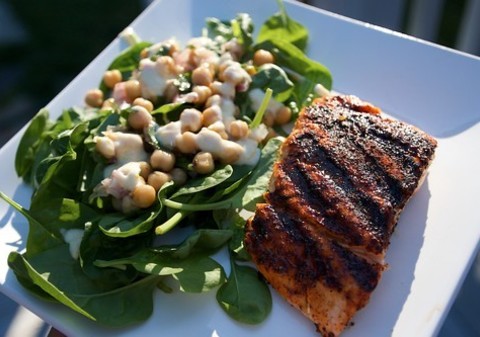
Spiced Rubbed Salmon with Chickpea Salad
0 notes
Note
Hey Najia! I love this blog so much! I have a question. I find cooking pretty difficult sometimes. I'm chronically ill and also the kitchen stresses me out a bit because I'm very scatterbrained and there's knives and fire and stuff. I also fuck things up in the kitchen pretty easy. Are there any recipes on here you find particularly easy to make? That you'd recommend for when you just cannot be arsed? Hope you're having a wonderful day, I know it's your birthday 😄🎉
Thank you!
I can understand your stress—cooking can involve things that are objectively dangerous and also time-sensitive. I'd recommend:
Try recipes where you don't have to come into direct contact with the blades you use. Some Indian dals, for example, cook lentils in a sauce made from blended onion, tomato, and garlic; you could process them using a food processor or blender. A lot of things (fresh salsa, guacamole, a duqqa of garlic, chilies, and spices that you can throw in to cook with some lentils) can be prepared in a mortar and pestle, too.
I've never used one, but a vegetable chopper might help in a similar way that a food processor would, by reducing the amount of knifework that you have to do. There are a lot of recipes where a chopped onion is the only knifework required.
Also try recipes that are cooked in the oven, and not on the stovetop. Something that gets thrown into the oven on low heat to cook (like a casserole or fukharat dish) takes longer, but is more hands-off, than something that's cooked on the stove.
Do all of your prep work first. Read through the recipe and see what chopping, blending &c. needs to be done, prep each ingredient, and put it in its own little bowl. This includes anything in the ingredients list that says "1 onion, diced" or similar: do that right off the bat. If the recipe says "meanwhile" or asks you to do prep for anything while anything else is cooking, you might choose to disregard that and do all the prep first, depending on how long the cook time is and how much attention it needs (e.g., soup on a low simmer for half an hour can pretty much be left alone; anything in a frying pan cannot). This way you won't be rushing to chop anything quickly while worrying that something else is going to overcook.
Look for vegetables, like broccoli / cauliflower / romanesco and green beans, that can be broken up with your hands rather than chopped. Rip up cilantro and parsley rather than chopping them.
Admittedly "simple" is not the guiding principle of this blog, but here are some recipes that I think could be easily adapted:
Fukharat l3des: just one onion to chop. Cooked on low heat in the oven.
Fried tofu sandwich: just mixing sauces and spices. You can skip coating the tofu in cornstarch and frying it. Instead try freezing the whole block, thawing it, cutting into two or four pieces, and then marinating it in a plastic bag with your sauce overnight. Then bake the tofu for 15-20 minutes, turning once, at 350 °F (180 °C).
Roasted celery and potato soup: requires only very rough chopping; the cooking methods are baking and simmering. The fried tempering could be skipped by just adding those ingredients into the simmer earlier.
Carrot salad or chickpea salad or tapenade: you could throw all of the ingredients in a food processor.
Moroccan lentils: just an onion and tomato to grate or process.
Kashmiri lal chaman: the only thing you need to cut is tofu; the gravy is just water and spices. You could bake the tofu instead of frying it.
Black bean burgers: no chopping or frying if you omit the onion and carrot and elect to bake the finished patties.
'Chicken' and olive tajine: the marinade is blended or pounded, and there is no other prepwork to do other than chopping one onion. Everything can be simmered on low heat until cooked, so it's pretty hands-off.
Chana pulao: mostly rice, chickpeas, and spices. Some aromatic prep, but you could crush instead of chopping those.
Romanesco quiche: no knifework at all if you omit the aromatics and break aprt the romanesco with your hands.
Spanish garlic mushrooms: just crush garlic instead of slicing and buy pre-sliced mushrooms. There is frying, though.
Eggplant cooked salad: the eggplant is broiled and then spooned out. No knifework required if you use tomato puree.
Butternut squash soup: just roasting and simmering. No knifework required if you omit the aromatics and buy pre-cubed squash.
Dishes with a base of lentils, chickpeas, beans, rice, and/or noodles are great because there's no knifework that needs to be done to prepare the beans &c. themselves.
161 notes
·
View notes
Text
16 Plant-Based Protein Sources
Protein is often raised as a concern for people considering adopting a plant-based diet, and considering the fact that we've all been taught to associate protein primarily with red meat, this is not surprising.
It is estimated that most adults require 56 grams of protein per day, and you're probably hitting that number if you're not in a calorie deficit. If you're trying to lose weight and so are cutting calories then you may need to track your protein a little more closely, but 56 grams is pretty easy to hit without having to really think about it.
It gets a bit more difficult if you're very physically active, particularly if you're engaged in regular endurance training or are trying to build muscle. There is a great deal of disagreement about precisely how much protein is ideal if you're training intensely, but it is very achievable to hit even the upper end of protein requirement estimates using only plant-based foods. Listed below are particularly good options.
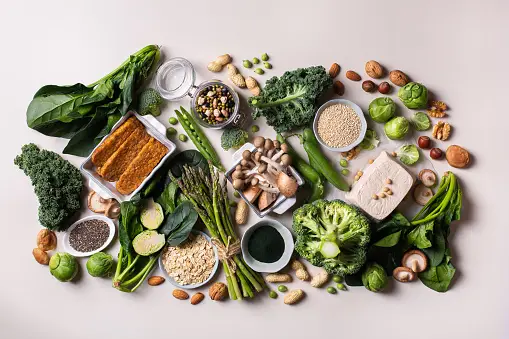
1) Lentils - Lentils are a cheap nutritional powerhouse, and provides about 17 grams of protein per cup. They're also very flexible, you can have them as your main protein source of a meal, use them to substitute mince in a pasta dish, make burgers out of them, or put them in a stir fry or with rice and veg with some seasonings. They are cheap and convenient if you buy them canned, since they're ready to eat, though I would recommend at least warming them up.
2) Chickpeas - Chickpeas are a popular vegan staple, and it's not hard to see why. At approximately 14.5 grams of protein per cup, they're nutrient dense and very flexible. Use them to make hummus or falafel, as the main protein source of a curry, on their own with rice or worked into a salad. You can also just air fry/grill them with some oil and spices for a convenient, crunchy snack.
3) Oats - A cup of dry oats is around 11 grams of protein by itself. Making it with a cup of oat milk brings that up to 14 grams, throw in a tablespoon of peanut butter and you're up to about 17.5 grams at breakfast, and all those ingredients are pretty cheap and very filling. You could add something like nuts or chia seeds as a topping to stretch that to well over 20 grams.
4) Nuts - Peanuts are 9.5 grams per 1/4 cup, almonds are 7g, pistachios 6g, cashews 5g, hazelnuts 5g, brazil nuts 4.75g, walnuts 4.5g and pine nuts are 4.5g. You can buy 1kg bags of mixed nuts for a little bit cheaper and keep them in a jar for a healthy snack. I find it better to buy a bag that doesn't have peanuts in then add the peanuts later, as mixes that include peanuts tend to be less for your money. Peanut butter is also a cost effective way to add protein to many snacks and meals.
5) Beans - Depending on the type, beans are anything from around 10-15 grams of protein per cup. Some are better than others, like kidney beans, but even your standard baked beans are high protein and good for you. Turn them into a chilli, have them on toast, on a jacket potato, turn them into a bean burger or make them the protein base of a salad or soup. Kidney , soy and edamame beans are particularly good options.
6) Seitan - When cooked, seitan closely resembles to look and feel of red meat. It is made of wheat gluten and has 25 grams of protein per 100 gram serving. It is not very widely available in supermarkets, but try your local Asian market, where it will usually be cheaper as well. It's a bit of a hassle, but you can also make your own at home, which is extremely cheap as it's just wheat gluten, yeast, plant milk, miso and spices.
7) Tofu/Tempeh - A staple in Asian cooking, don't be afraid to try this one. Think of it as doing all the same things chicken does in terms of recipes, it soaks up the flavour around it. It needs to be pressed before use, or you can avoid that by just draining the liquid and freezing it, then thawing over night when you want to use it. 100 grams of tofu (less than half a small block) contains 8 grams of protein. Some tofu, like Naked TooFoo, is pre-pressed for you.
8) Faux Meats - Faux meats are an easy way to add a protein base to your meal, and has the advantage of serving the same function on a plate as the foods you were used to before you went vegan. A Beyond burger, for example, has 19g of protien per patty, though you can get much cheaper options that have a similar nutritional profile. Pair that with a wholemeal bun and something like brown rice/quinoa and vegetables and you can create a very high protein meal.
9) Grains - All grains are good for protein, these include quinoa, spelt, brown/wild rice, teff, amaranth and sorghum. They can range anywhere between 5 and 8 grams per 100 grams, and you'll usually be serving them with some sort of protein source. They're also an excellent source of fibre and carbohydrates, which are also important for training and general health. Quinoa in particular provides all 22 essential amino acids.
10) Peas - Green peas are not mentioned much when it comes to high protein options, but a cup of cooked peas is a respectable 9 grams of protein, and it's worth mentioning here because they tend to be used more as a side than main, so can be paired with other high protein options. They're also very cheap, freeze well and are easy to prepare.
11) Seeds - Just a tablespoon of chia seeds is nearly 3 grams of protein, and the seeds are so small and tasteless that you don't actually notice them in anything you put them in, making them an easy way to add protein to just about any meal. They're pretty cheap to buy in large quantities, particularly good to replace eggs in baking, to add to bread flour, salads and oatmeal. Other high protein seeds include pumpkin, sunflower, linseed, hempseeds and buckwheat.
12) Bread - Bread may not immediately come to mind when you're thinking about protein, but wholegrain/rye/spelt breads can be very high in protein, anywhere from 3 all the way up to around 10 grams per slice, particularly for seeded loaves. If you really want to turn bread into a high protein food, invest in a bread maker or bake it yourself, that way you can add nuts, seeds and oats yourself to up the nutritional value. That's just the bread too, a hummus and falafel sandwich with a high protein bread can be very nutrionally dense.
13) Fruit and veg - Worth mentioning here, as they're something you'll need to consume to maintain a healthy diet anyway, and some options have moderate protein. The higher protein options include broccoli, spinach, asparagus, artichokes, potatoes, sweet potatoes and Brussels sprouts, which all contain 4–5 grams of protein per cooked cup. Likewise, blueberries, guava, bananas and nectarines contain about 2-4 grams of protein per cup, as well as many other vitamins important for training.
14) Nutritional Yeast - No vegan list is complete without mentioning it, it's a vegan staple for its nutty, cheesy flavour, as well as being an easy source of vitamin B12. It's a complete protein that has 8 grams of protein per 16 grams serving, making it an easy way to add more protein to things like pizza, pasta dishes or a jacket potato. Use it to make cheesy sauces, or just sprinkle it on anything you'd have previousy added parmesan cheese to.
15) Protein Bars - They tend to be on the expensive side, but there are a few plant-based options. I'd recommend Misfit bars if you can get them online, they're low sugar, 15g of protein per bar, and you can buy them in variety packs of 40 which works out cheaper. Trek also have protein flapjack bars, less protein (8-9g) but are much cheaper in packs of 3 and frequently available at a discount (as little at 85p for three in Heron here in the UK).
Most brands won’t be suitable as a daily option for many people given the price, but great for when you're need a protein boost on the go. You can also just make your own protein bars using nothing but oats, cinnamon, baking soda, a little maple/golden syrup and a scoop of plant-based protein powder.
16) Protein/Meal Powders- Even the cheaper powders are around 18g of protein per scoop, so a shake is an easy way to add more protein to your diet, or you can stir it into oatmeal to get most of your daily requirements over breakfast. Some meal replacement shakes, like Huel Black, are around 40 grams of protein per serving (2 scoops) even when made with just water, providing a cheap and easy way to have a high protein and nutritious meal without any prep or fuss. Add some peanut butter and plant milk to make them tastier and even higher in protein.
(I don't accept sponsorship or commissions from any brand and I don't have any affiliate links. Any product recommendations are based solely on my own experience.)
95 notes
·
View notes
Note
I've been dying to try making new food but I'm usually too paranoid to go outside of my comfort zone of Mexican or Italian, what's something you'd suggest to someone that would be a gateway to making other types of food?
Do you like "beans with a bunch of spices / other seasonings on 'em" kind of meals. Mexican & Italian both got meals like this. Put a can of chickpeas in a pan with some oil and some garlic, add whatever spices you like that you're familiar with, and fry 'em until they're golden and a little crisp on the outside. I like to eat it with rice or flatbread, and a simple salad, and sometimes a bit of feta or cotija or similar texture cheese. If you eat this and think "oh that's good" go look up & try chana masala. Then open your world to other Indian food and / or other curries.
There's a decent amount of overlap between Italian and Greek flavour profiles and ingredients.
You probably already like pasta or rice dishes. Good news: there's noodle and rice dishes all over the world. (Spaghetti's usually cooked to a different level of doneness than other noodles in other dishes, so the texture's not going to be exactly one-to-one here, but it's still an awesome wet long bread.) You don't even gotta make anything complex. Fried rice can be as simple as "day-or-two old white rice, an egg, soy sauce, and whatever veggies I have lying around".
Sometimes just forcing yourself out of your comfort zone at a restaurant is the move. Go to a place you don't normally go or get a thing you don't normally get. And then if you like it you can look into how to make it yourself, or try to look up things similar to it.
There's a million other things you can do, and these aren't the End All Be All of how to make and eat food (frankly that'd just be "make and eat food"), but I could be here all day and throw too many ideas out and it'd probably be overwhelming. So here's a few. Maybe they work out for you or maybe they don't. I wish you success in finding other cool meals to try all the same.
132 notes
·
View notes